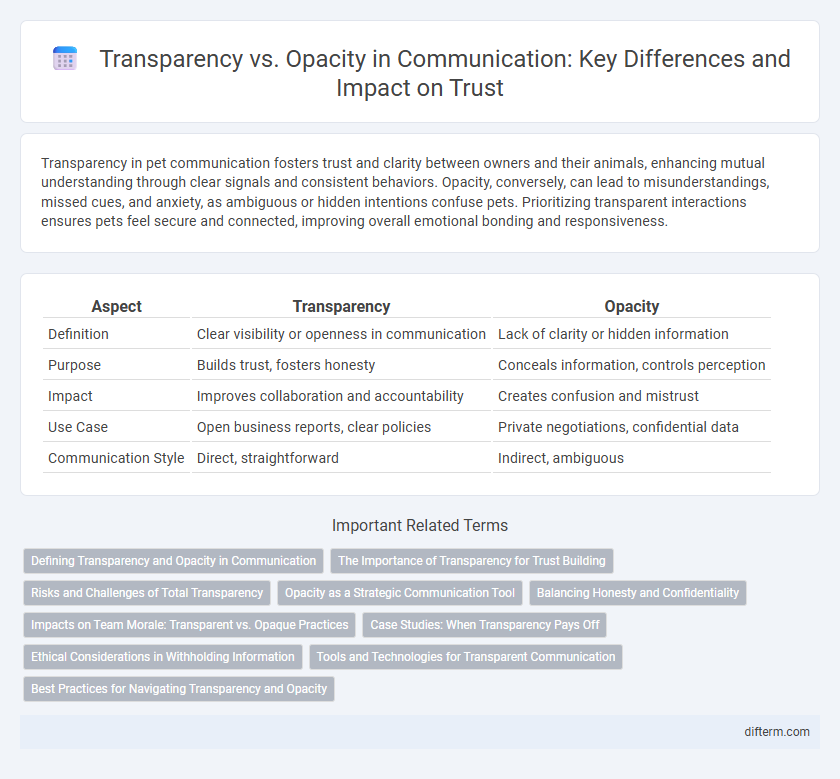Transparency in pet communication fosters trust and clarity between owners and their animals, enhancing mutual understanding through clear signals and consistent behaviors. Opacity, conversely, can lead to misunderstandings, missed cues, and anxiety, as ambiguous or hidden intentions confuse pets. Prioritizing transparent interactions ensures pets feel secure and connected, improving overall emotional bonding and responsiveness.
Table of Comparison
| Aspect | Transparency | Opacity |
|---|---|---|
| Definition | Clear visibility or openness in communication | Lack of clarity or hidden information |
| Purpose | Builds trust, fosters honesty | Conceals information, controls perception |
| Impact | Improves collaboration and accountability | Creates confusion and mistrust |
| Use Case | Open business reports, clear policies | Private negotiations, confidential data |
| Communication Style | Direct, straightforward | Indirect, ambiguous |
Defining Transparency and Opacity in Communication
Transparency in communication involves openly sharing information, intentions, and decision-making processes to build trust and clarity among participants. Opacity, in contrast, refers to withholding or obscuring information, which can lead to misunderstandings, mistrust, and reduced collaboration. Effective communication depends on balancing transparency to foster openness while managing sensitive information appropriately.
The Importance of Transparency for Trust Building
Transparency in communication fosters trust by ensuring clarity, honesty, and openness between parties. When organizations or individuals share information openly, they reduce misunderstandings and build credibility. This trust forms a foundation for stronger relationships, collaboration, and long-term success.
Risks and Challenges of Total Transparency
Total transparency in communication can expose sensitive information, increasing cybersecurity risks and potential misuse by malicious actors. It can also undermine trust, as individuals may feel vulnerable or overly scrutinized, leading to decreased openness and collaboration. Balancing transparency with privacy safeguards remains a critical challenge for organizations navigating ethical and security concerns.
Opacity as a Strategic Communication Tool
Opacity as a strategic communication tool involves deliberately withholding information to control the narrative and protect sensitive interests. Organizations use opacity to create ambiguity, manage uncertainty, and shape stakeholder perceptions without full disclosure. This approach can enhance competitive advantage by limiting external scrutiny and maintaining negotiation leverage.
Balancing Honesty and Confidentiality
Balancing honesty and confidentiality requires clear communication strategies that maintain transparency without compromising sensitive information. Organizations must establish protocols to share relevant facts openly while safeguarding privacy and proprietary data. Effective transparency enhances trust and collaboration, whereas controlled opacity protects competitive advantage and personal boundaries.
Impacts on Team Morale: Transparent vs. Opaque Practices
Transparent communication fosters trust, collaboration, and a sense of psychological safety within teams, directly boosting morale and productivity. In contrast, opaque practices often lead to confusion, mistrust, and disengagement, undermining team cohesion and increasing turnover rates. Studies show that organizations prioritizing transparency experience up to 25% higher employee satisfaction and retention compared to those with limited information sharing.
Case Studies: When Transparency Pays Off
Case studies reveal that transparency enhances trust and customer loyalty, leading to increased brand reputation and long-term profitability. Organizations that openly share information during crises, such as Johnson & Johnson's Tylenol recall, demonstrate accountability and foster consumer confidence. Transparency in communication accelerates problem-solving and innovation by encouraging stakeholder collaboration and feedback.
Ethical Considerations in Withholding Information
Withholding information in communication raises significant ethical considerations, as transparency fosters trust, accountability, and informed decision-making. Opacity can erode credibility, leading to misunderstanding and potential harm, especially in contexts involving public interest or stakeholder relations. Ethical communication demands balancing the necessity of confidentiality with the imperative for openness to uphold integrity and respect.
Tools and Technologies for Transparent Communication
Advanced collaboration platforms such as Slack and Microsoft Teams enhance transparency by providing real-time message sharing and document editing, fostering open dialogue. Video conferencing tools like Zoom and Google Meet support face-to-face interactions that reduce misunderstandings and build trust. Encryption technologies ensure secure communication while maintaining transparency without compromising data privacy.
Best Practices for Navigating Transparency and Opacity
Effective communication balances transparency and opacity by clearly defining what information is shared and what remains confidential to build trust and protect sensitive data. Establishing consistent guidelines ensures transparency aligns with organizational values while opacity safeguards privacy and competitive advantage. Regular training and feedback loops enhance understanding, helping stakeholders navigate the nuances between open information exchange and necessary discretion.
transparency vs opacity Infographic

 difterm.com
difterm.com